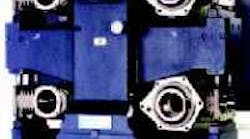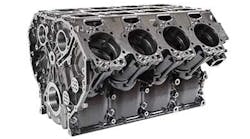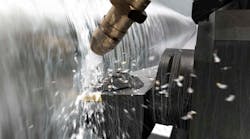When — and when not to — pile parts onto workholding fixtures.
Integral-pallet tombstones combine machine pallet and fixture as one, which gives shops more high-production workholding options because the fixture sits lower in the machine's work zone.
Two types of high-production workholding are hydraulic clamp/unclamp and mechanical clamp/hydraulic unclamp.
Fixture economics indicate a shop's "sweet spot" for high-production workholding.
Makino's continuous-pressure-hydraulics system accommodates up to a 12-port rotary union and uses hydraulics, air, or both in any one of the ports for high-production workholding.
When it comes to workholding for high production, most shops pack fixtures with as many parts as possible. A full fixture, in some cases, is advantageous, but in others, it could do more harm than good. For high-production, shops not only need to determine an optimum, or proper, number of parts per fixture but also choose the appropriate type of fixture by considering the latest CNC-workholding technology.
Determining that "right" number of parts per fixture takes what's called fixture economics. Instead of supply and demand, fixture economics deals with cycle time/part versus parts/fixture. More parts/fixture means shorter cycle time/part, but there is a point of diminishing returns.
According to machine tool builder Makino of Mason, Ohio, as the number of parts loaded on a fixture increases, so too does the cost of that fixture. "The sweet spot for high production," says Bob Kuzner, manager of Makino's workholding group, "is where cycle time/part intersects with fixture cost."
To find their workholding sweet spots, shops should weigh how several issues apply to their own machining operations. These include non-cut time amortization, processes and quality, maintenance, cutting forces, and locating and clamping points.
Non-cut time amortization relates to the desire to minimize toolchange times by loading more parts on a fixture. However, process and quality issues arise as shops increase the number of parts. But more parts translates into more processes and a higher cost of controlling, or ensuring the quality of, those processes. Using more fixtures also drives up maintenance costs, which is another important consideration.
In addition, cutting forces and locating/clamping points dictate the necessary size and type of fixturing. Shops that opt for less-expensive workholding may find their fixtures can't handle the cutting forces or hold parts properly for specific jobs.
For optimum high-production workholding, Makino recommends concurrent engineering. If possible, shops should work with their product engineers to marry part manufacturability with end-product functionality. This can reduce fixture and overall part-process costs.
Obviously, the type of fixture used determines fixture cost, and there are several to choose from. For high production, workholding fixtures should be robust and provide easy loading and unloading, while delivering repeatable part locating and consistent clamping force. They should also accommodate different part types for a high-product mix and give shops enough creativity for increasing machine tool productivity.
Most high-production workholding is automated, and there are two basic types: hydraulic and mechanical. The most commonly used hydraulic styles for high production are single action/spring return and full-double action.
On a single-action/spring-return fixture, hydraulics close clamps, and springs release them. For a full double-action fixture, hydraulics both clamp and unclamp.
However, using full double-action fixtures in a flexible-machining cell does require an accumulator, which locks hydraulic pressure in the fixture. This eliminates the need to continuously introduce pressure into the system.
Mechanical clamping is an alternative to automated clamping for high production. In the mechanicalclamping/hydraulic-unclamping style, Belleville-washer stacks provide clamping force and hydraulics the unclamping force — minus accumulators. With this type of fixture, parts remain clamped if a shop loses hydraulic pressure.
However, according to Kuzner, there aren't many commercially available mechanical-clamping/ hydraulic-fixture products, so most are custom made. Also, Belleville washers may limit clamp-throat depth, which means less clamp travel for loading and unloading parts.
Another mechanical clamping method uses nut runners. Basically, a nut on top of an Acme screw thread drives the clamp onto the part using the thread as the holding force. This type of fixturing is sometimes used in high-production environments.
No matter what fixture type, hydraulic or mechanical, it most likely gets mounted to a workholding tombstone. And one tombstone style, in particular, offers several advantages for high-production workholding.
Integral-pallet tombstones combine the machine pallet and fixture as one, instead of the fixture resting on the machine's pallet. Combining the two gives shops more workholding options because the fixture sits lower in the machine's work zone — there's more usable Y-axis space. This type of tombstone eliminates tolerance stacking between a separate pallet and fixture. It also reduces the number of machined surfaces — like the top surface of the pallet and the bottom one on the fixture.
Besides hydraulic and mechanical clamping, two other nonconventional systems also apply to high-production work-holding. They are vacuum and magnetic fixturing, and both let shops access five part sides without fixture interference.
Vacuum fixturing is popular in aerospace shops because it easily holds thin-walled aluminum parts. Magnetic fixturing is for ferrous-type components, and it excels in securing large, heavy workpieces.
Thanks to CNC, emerging technologies offer shops additional ways to optimize workholding for high production. Three such technologies that Makino provides for its customers are continuous-pressure hydraulics (CPH), electrical part sensing, and through-fixture coolant.
Some of Makino's latest machining centers sport CPH. The system accommodates up to a 12-port rotary union and uses hydraulics, air, or both in any one of the ports. Makino's system pumps out up to 3,000 psi, while others on the market generate 1,000 psi or less and require an intensifier.
Makino foresees many possibilities with CPH, one of which is the ability to move clamps during machining. Using N and G codes, shops open a clamp for an approaching cutter and close it once the cutter passes by.
Two other possibilities are being able to release/reduce pressure during a clamping cycle and also adjust hydraulic pressure. Having this control, for instance, lets shops adjust clamping pressure to relieve residual stress resulting from removing large amounts of material from a workpiece. "With CPH, there are hundreds of possible configurations using air and hydraulics," says Kuzner.
Part sensing, according to Makino, is often critical in high-productionworkholding environments, especially when robots are loading and unloading machine tools. Situations such as power outages may disrupt settings on robots, causing them to attempt loading a fixture already holding a workpiece.
Makino's sensing system provides up to eight limit switches per sending unit, which are wired to the fixture and machine. They align with each other but do not couple. "Part sensing foolproofs the workholding system and reduces scrap," says Kuzner.
In some high-production applications, Makino incorporates part-seating sensing. For instance, the company may use air lines and air orifices at the main locating points of a fixture to ensure parts seat completely against the locator. If they don't, the unit sends an alarm to the machine.
Both part and part-seating sensing require clean fixture surfaces. For this, Makino typically installs coolant-through fixturing, which washes chips and debris from workholding components and air orifices.











